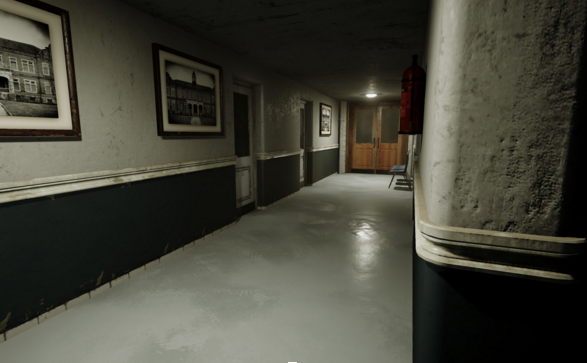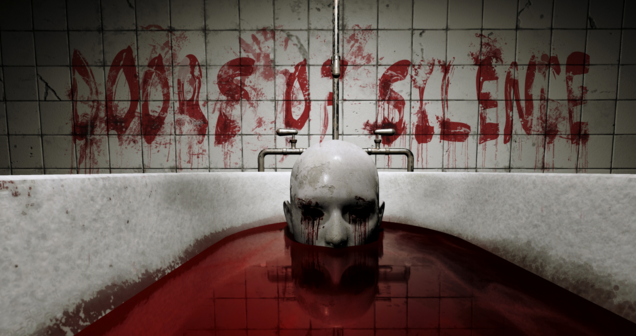If you’ve played with one of Gelardin’s two Oculus Rifts in the past few months, you may have noticed a particularly frightening Virtual Reality Experience on the menu: Doors of Silence. DoS is a horror experience, currently in its demo stage, that places the player in a run-down compound, complete with a terrifying, immersive atmosphere and frights at every turn.
I was fortunate enough to speak over email with DoS’ lead developer Giuseppe Belfiore about his experiences in game development, the horror genre, and virtual reality. Check out our conversation below.
Halftime Staff: What inspired you to create Doors of Silence?
GB: We have our roots in horror films from the 70’s and 80’s by the masters Dario Argento, John Romero, Sam Raimi, Wes Craven and John Carpenter. During our years at university, there were cult video games, the saga Resident Evil, Silent Hill, and Sanitarium that left a profound impression in our minds. There are some references present in the DoS demo, both wanted and not, but they’re not easy to find.
Halftime Staff: What characters can players encounter in the game?
GB: We can’t give away the characters in the final version for obvious reasons, but what we can say, in respect to the demo, [is that] they will undergo a notable graphic restyling to make them more captivating, disturbing, and frightening. Each one will have peculiar attributes that will influence the gameplay and the way necessary to rid yourself of them, or escape.
Halftime Staff: What do you hope players will experience when they play Doors on the Oculus Rift?
GB: In part what players have experienced in the demo, though the first episode of DoS will have many new features. Whilst abandoning the frontality of the medium and attempting to create a connection for each player, what we want most of all is that the experience be individual. Every experience in life, for as much as they are shared with others, is multi-faceted that depend on the individual; our goal is to draw from these personal experiences of each player.
Halftime Staff: Much of DoS’s thrill comes from the immersive atmosphere you’ve created. Did you know you wanted to release this game for virtual reality, or did you consider other platforms?
GB: DoS was principally designed for VR, at the same time, we’re not excluding future possibilities. From the outset we had discussed what we wanted to prove and release for the VR community, and the project itself is much more complex than the demo in many respects. The first trial that the team wanted to take on was the game environment, in thinking the relationship between player and game world has mutated entirely. The way a player relates to a video game in the classical frontal format is extremely limiting, whereas in a virtual world, time and the perception of space have a different meaning, aspects we felt had to be considered for the project DoS.

Giuseppe Belfiore
Halftime Staff: Were there any major changes made during development that significantly changed the game, or was it essentially the same playthrough from its conception to release?
GB: The initial idea for the project has not undergone major changes during its development, nevertheless, and in consideration of this new sector, where new forms of expression and design can be made, we’ve recalibrated certain aspects and tried new solutions, some notably different than others. One of the aspects we delved into is the relationship between space and time in a virtual world and how that was to be considered. A virtual world is a complex environment defined by a highly immersive graphic interface that permits us to experiment with being physically present in another world; a world in which we interact with the same senses and considerations used in the external world.
Halftime Staff: How did you get into the game development field?
GB: Our interest in game development was born out of a passion for playing video games that started in the 1980’s when the first consoles and home computers arrived. We’re game players that switched sides, from users to game makers. It’s not easy because we earn our livings elsewhere, but the passion and will to experiment, create, and to tell stories pushed us to overcome the difficulties of adopting new ways of thinking and applying new methodologies.
Halftime Staff: What drew you to the horror genre? And, within that genre, what drew you to a more atmospheric horror game?
GB: Everything emerged from one simple philosophical concept, namely that the waiting is the most important part of an emotion. We feel that this aspect is of fundamental importance to a horror game. It’s easier to frighten players by constructing a path based on a sequence of sudden violent events (jump-scare techniques), but we feel it would take away from the concept fundamental to our work and discourage the exploration of the game environment. What we are aiming for, is to constantly trigger the fear of the unknown in the player, or an unsettling feeling or discomfort roused by finding yourself in a mysterious place, possibly hiding something terrible and monstrous. From this point of view, VR is crucial because it amplifies these feelings in an exponential manner.
Halftime Staff: Georgetown has two Oculus Rifts for student and faculty use. Where do you see video games/virtual reality and academics intersecting?
GB: Academia continually makes use of new technologies and methodologies for teaching and experimentation, and, if used in the right way, VR could be a very useful instrument to mediate between theoretical studies and the real world. Until recently, the virtual world was accessible only to heavily funded sectors, but now the technology is accessible even at a low cost and that will favor the proliferation of projects using this approach.
Halftime Staff: Where do you see video games and virtual reality going in the future?
GB: We are at the dawn of a new era; the devices launched this year represent only the beginning of a new world waiting to be explored, where boundaries are entirely unknown. In this vast universe, video games will cut an important swath, and, as usual, act as a runway for launching and diffusing VR. Clearly, the mechanics of the game are not yet completely adapted to this new media[. F]or this reason, assisting in revolutionizing the field of gaming will help us to overturn the limits imposed by the technology of today.
Halftime Staff: Do you have any future projects? Do you plan to stay in the horror genre, or explore others?
GB: At the moment our objective is to create a horror video game that could leave an impression on the individual player. Doors of Silence was designed as one episode of a series, similar to a novel with distant beginnings that in its breadth follows through to the present day. In the coming years, we will be developing new episodes carried over from the project’s design stage, therefore remaining in the genre of horror. At the same time we are not excluding other possibilities in the field of VR.
From the Doors of Silence development team: We’ll say goodbye leaving you with a date to mark on your calendar: April 26 2016.
——-
To check out Doors of Silence, visit their website, or experience it for yourself: simply head down to the first floor of Lauinger Library and inquire at Gelardin’s desk.





